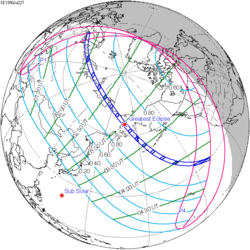| Annular eclipse | |
| Gamma | −0.9228 |
|---|---|
| Magnitude | 0.9752 |
| Maximum eclipse | |
| Duration | 90 s (1 min 30 s) |
| Coordinates | 83°30′S9°24′E / 83.5°S 9.4°E |
| Max. width of band | 234 km (145 mi) |
| Times (UTC) | |
| Greatest eclipse | 17:59:52 |
| References | |
| Saros | 121 (56 of 71) |
| Catalog # (SE5000) | 9366 |
An annular solar eclipse occurred at the Moon's ascending node of orbit on Wednesday, December 25, 1935, [1] with a magnitude of 0.9752. A solar eclipse occurs when the Moon passes between Earth and the Sun, thereby totally or partly obscuring the image of the Sun for a viewer on Earth. An annular solar eclipse occurs when the Moon's apparent diameter is smaller than the Sun's, blocking most of the Sun's light and causing the Sun to look like an annulus (ring). An annular eclipse appears as a partial eclipse over a region of the Earth thousands of kilometres wide. The Moon's apparent diameter was near the average diameter because it occurred 7.7 days after apogee (on December 18, 1935, at 2:40 UTC) and 4.8 days before perigee (on December 30, 1935, at 15:10 UTC). [2]
Contents
- Eclipse details
- Eclipse season
- Related eclipses
- Eclipses in 1935
- Metonic
- Tzolkinex
- Half-Saros
- Tritos
- Solar Saros 121
- Inex
- Triad
- Solar eclipses of 1935–1938
- Saros 121
- Metonic series
- Tritos series
- Inex series
- Notes
- References
This was the last of five solar eclipses in 1935, with the others occurring on January 5, February 3, June 30, and July 30. The next time this will occur is 2206.
Annularity was visible from parts of Antarctica. A partial eclipse was visible for parts of Antarctica, southern South America, and New Zealand.
It was the first solar eclipse to fall on Christmas Day since 1685, and the last until the 1954 eclipse. [3] : 137







































































































